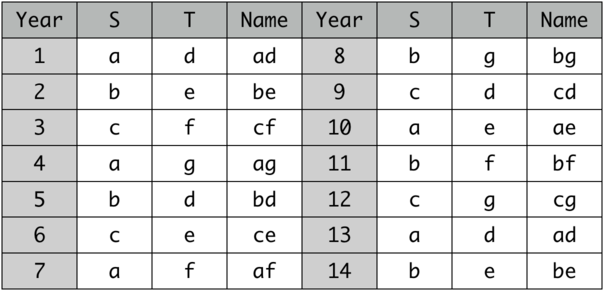CF1284A New Year and Naming
题目描述
新年快乐!在韩国 $2020$ 年也被称为庆州年(Year Gyeongja,경자년,gyeongja-nyeon)。该名字从何而来?让我们简要的看一下韩国传统的给年份命名的系统 $Gapja \ system$。
这里有两个序列,元素都是字符串,长度分别为 $n$、$m$,元素分别为 $s_1,s_2,s_3,\dots,s_n$、$t_1,t_2,t_3,\dots,t_n$。这些字符串只包含小写字母。可能有相同的字符串。
我们将在不改变顺序的前提下将字符串 $x$ 与 $y$ 写下来得到的字符串称作字符串 $x$ 与字符串 $y$ 的串联。例如:“code”和“forces”的串联字符串为“codeforces”。
第一年被命名为 $s_1$ 和 $t_1$ 的串联,当年份增加一时,两个被串联在一起的字符串下标加一。如果超出了字符串序列的长度,则超出长度的那一个序列回到序列开始的位置,也就是下标为 $1$ 的位置。
例如:如果 $n=3,m=4,s=$\{"a","b","c"\} , $t=\{"d","e","f","g"\}$,产生的年份的名称如下表所示
注意年份的名称可以重复。
给你两个序列长度分别为 $n$,$m$ 和 $q$ 个询问。每个查询给你当前的年份,请你从 $Gapja \ system$ 系统中找出它的名字。
输入格式
第一行有两个整数 $n,m \ (1 \le n,m \le 20)$。
下一行有由空格分隔的 $n$ 个字符串 $s_1,s_2,s_3,\dots,s_n$,每个字符串仅有小写字母构成,字符串的长度在一到十之间。
下一行有由空格分隔的 $m$ 个字符串 $t_1,t_2,t_3,\dots,t_m$,每个字符串仅有小写字母构成,字符串的长度在一到十之间。
所给的字符串中可能有重复。
下一行一个整数 $q \ (1 \le q \le 2020)$ 表示询问的个数。
接下来的 $q$ 行,每行一个整数 $y \ (1 \le y \le 10 ^ 9)$,表示询问你年份 $y$ 的名称。
输出格式
输出共 $q$ 行,第 $i$ 行表示第 $i$ 个询问的答案。
说明/提示
字符串序列的长度 $n,m$ 满足 $1 \le n,m \le 20$。
询问个数 $q$ 满足 $1 \le q \le 2020$。
询问的年份 $y$ 满足 $1 \le y \le 10 ^ 9$
**关于样例**
第一个样例使用的是实际的 $Gapja \ system$。这些字符串一般是数字或动物的名称。
translated by [yu__xuan](https://www.luogu.com.cn/user/142110)。